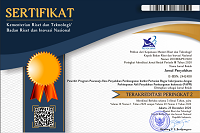Model dan Gaya Komunikasi dalam Program Upaya Khusus Padi Jagung Kedelai
Abstract
The aim of this research was to examine the model and the style of communication used in the Special Effort Program for Increasing Paddy, Corn and Soybean Production (UPSUS PAJALE). This research was conducted in Tulungagung Regency, East Java Province. This research was a descriptive qualitative research. The research strategy used was a case study. Data collection techniques used in this study were: (1) Observation, (2) In-depth interview, (3) Reviewing documents and archives, and (4) Data collection with Focus Group Discussion (FGD) as a support. The communication model used in UPSUS program in Tulungagung District was a communication model of chain structure in the form of coordinative and linear relationship. UPSUS program communication model in Tulungagung Regency was considered not effective in UPSUS program delivery so there was still a lot of miscommunication at the implementation level below between extension worker with Babinsa and Extension Worker with Mantri Tani. This was because there is no cross-sector coordination and was caused by the controlling style of the stakeholders because of pressure from their superiors, which in the end the interactive communication or effective participatory communication didn't occur.Downloads
References
Badan Penyuluhan dan Pengembangan SDM Pertanian. 2015. Petunjuk Pelaksanaan Pendampingan Mahasiswa dalam Upaya Khusus Peningkatan Produksi Padi, Jagung dan Kedelai. Jakarta: Kementerian Pertanian
Badan Penyuluhan dan Pengembangan SDM Pertanian. 2015. Petunjuk Pelaksanaan Pengawalan dan Pendampingan Penyuluh di Lokasi Sentra Padi Jagung dan Kedelai. Jakarta: Kementerian Pertanian
Devito A. Joseph. 2011. Komunikasi Antarmanusia- edisi kelima.. Tangerang: Karisma Publishing Group
Direktorat Jenderal Prasaranan dan Sarana Pertanian. 2015. Pedoman Upaya Khusus Peningkatan Produksi Padi, Jagung dan Kedelai melalui Program Perbaikan Jaringan Irigasi dan Sarana Pendukungnya TA 2015. Jakarta: Kementerian Pertanian
Faridhavin, U., R. Witjaksono., Harsoyo. 2016. Persepsi Pendamping Terhadap Pelaksanaan Program Upsus Pajale Di Daerah Istimewa Yogyakarta. Agro Ekonomi Vol. 27/No. 2: 77-94
Kementerian Pertanian. 2015. Permentan No. 14/Permentan/OT.140/3/2015 tentang Pedoman Pengawalan dan Pendampingan Terpadu Penyuluh, Mahasiswa, dan Bintara Pembina Desa Dalam Rangka Upaya Khusus Peningkatan Produksi Padi Jagung dan Kedelai. Berita Negara Republik Indonesia Tahun 2015 Nomor 486. Jakarta: Kementerian Hukum dan HAM
Men, L. R. 2015. The Internal Communication Role of the Chief Executive Officer: Communication Channels, Style, and Effectiveness. Public Relations Review. http://dx.doi.org/10.1016/j.pubrev.2015.06.021
Ohlrogge, A.W., Suggs, L.S. 2018. Flu Vaccination Communication in Europe: What Does the Government Communicate and how. Vaccine. https://doi.org/10.1016/j.vaccine.2018.04.042
Pawito. 2007. Penelitian Komunikasi Kualitatif. Yogyakarta: LKIS
Republik Indonesia. 2012. Undang-undang No. 18 Tahun 2012 tentang Pangan. Lembaran Negara Republik Indonesia Tahun 2012 Nomor 227. Jakarta: Kementerian Hukum dan HAM
Sadono, D., 2009. Perkembangan Pola Komunikasi dalam Penyuluhan Pertanian di Indonesia. Jurnal Komunikasi Pembangunan Vol. 07, No. 2: 43-56
Sendjdja, S.D., 2009. Teori Komunikasi. Jakarta: Universitas Terbuka
Sugiyono. 2010. Memahami Penelitian Kualitatif. Bandung: Penerbit Alfabeta.
West, R. dan L.H. Turner. 2008 Pengantar Teori Komunikasi, Analisis dan Aplikasi. Jakarta: Salemba Humanika
Authors who publish with this journal agree to the following terms:
- Authors retain copyright and grant the journal right of first publication with the work simultaneously licensed under a

This work is licensed under a Creative Commons Attribution 4.0 International License that allows others to share the work with an acknowledgement of the work's authorship and initial publication in this journal. - Authors are able to enter into separate, additional contractual arrangements for the non-exclusive distribution of the journal's published version of the work (e.g., post it to an institutional repository or publish it in a book), with an acknowledgement of its initial publication in this journal.
- Authors are permitted and encouraged to post their work online (e.g., in institutional repositories or on their website) prior to and during the submission process, as it can lead to productive exchanges, as well as earlier and greater citation of published work (See The Effect of Open Access).















